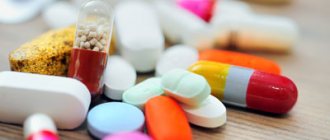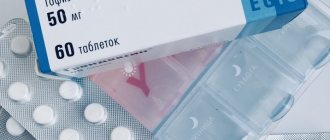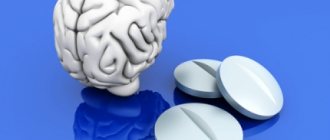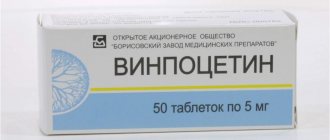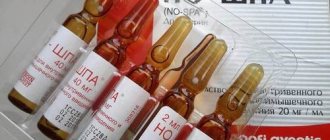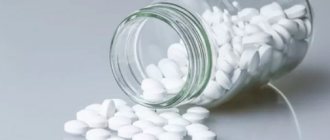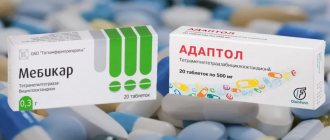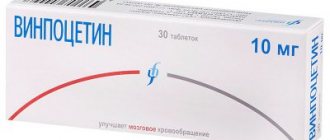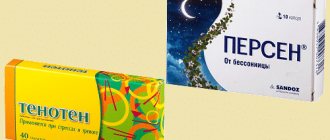Tranquilizers are a group of psychotropic drugs with an anti-anxiety effect, relieving anxiety and internal tension, anxiety, tremors and muscle tension of neurotic origin, and a feeling of fear. Some drugs in this group, in addition to their normalizing psycho-emotional state and nighttime sleep effect, can have a tonic effect.
Among tranquilizers (from the Latin tranquillo - to calm down) there are typical and atypical ones, which do not have pronounced non-core effects and do not cause dependence when taken for a long time. Based on their chemical structure, anxiolytics are divided into benzodiazepine derivatives (chlordiazepoxide, diazepam, phenazepam, oxazepam, medazepam, midazolam) and drugs of other chemical groups (meprotane, benactizine, phenibut, mebicar, benzoclidine).
The pharmacodynamic activity of all anxiolytics comes down to five main components: sedative, anti-anxiety, hypnotic, relaxant and anticonvulsant. Each specific drug has its own degree of severity of a particular therapeutic effect, which determines its clinical use (for example, in psychiatry, neurology, cardiology, gastroenterology, otolaryngology, anesthesiology).
Anxiolytics are prescribed to relieve states of agitation (1) and asthenia (2) accompanying various mental disorders:
- anxiety, panic, fear, irritability, dysphoria, problems with going to bed, decreased sleep duration, autonomic lability, autonomic crises;
- asthenia, chronic fatigue, hypochondria, problems with attention and remembering information, decreased intellectual activity, weakness, fatigue, lethargy, apathy, irritability, lack of vigor after sleep.
As a rule, the above conditions occur against the background of the following mental disorders:
- neuroses and neurosis-like conditions (F40–F48);
- behavioral disorders in children and adolescents (F91);
- personality disorders (F60–F69);
- fears and phobias (F40);
- insomnia (F51);
- panic attacks (F41);
- generalized anxiety disorder (F41.1);
- mixed anxiety and depressive disorder (F41.2);
- schizotypal disorder (F21);
- acute psychoses (F23, tranquilizers are prescribed as part of complex therapy);
- anorexia (F50.0–F50.1 and bulimia (F50.2);
- psychosomatic diseases (F04–07; F44.4–F44.7; F45; F50–F53).
In the practice of a neurologist, tranquilizers can be prescribed, for example, when states of agitation and asthenia occur due to traumatic brain injuries, strokes accompanied by increased muscle tone, epilepsy, and spinal osteochondrosis. Other somatic doctors prescribe anxiolytics for the treatment of functional disorders in the gastrointestinal tract (gastroenterologist), cardiovascular system (cardiologist), urinary system (gynecologist, urologist), withdrawal states and consequences of organic damage to the central nervous system (narcologist, toxicologist).
Mechanism of action of tranquilizers
The therapeutic mechanism of action of tranquilizers is the ability to influence the interneuronal transmission of nerve impulses in the diencephalon (intermediate) and spinal cord, reduce the activity of subcortical areas of the brain, reduce the level of dopamine and norepinephrine, as well as processes in the GABA systems of the brain, and block cholinergic receptors.
A feature of the therapeutic effect of tranquilizers is a calming effect on the central nervous system, excluding a pronounced antipsychotic effect. Therefore, they are widely used for mild (reversible) disorders of the central nervous system as an alternative to antipsychotic drugs.
The mechanism of action of tranquilizers depends on their chemical structure. Among anxiolytics, six classes of organic substances can be distinguished, represented by main chemical groups (according to the Anatomical Therapeutic Chemical Classification of Medicines, ATC):
- benzodiazepine derivatives;
- diphenylmethane derivatives;
- carbamates;
- dibenzo-bicyclo-octadiene derivatives;
- azaspirodecanedione derivatives;
- other anxiolytics.
The targets of anxiolytics are the following brain structures:
- limbic system of the hypothalamus;
- reticular formation of the brain stem,
- thalamic nuclei.
To date, the mechanism of action of tranquilizers of benzodiazepine derivatives has been well studied. Benzodiazepine receptors are involved in biochemical processes associated with GABAergic inhibition at all levels of the central nervous system. The versatile activity of tranquilizers is determined by their effect on various types of benzodiazepine receptors, thus allowing them to have anxiolytic, sedative, hypnotic, muscle relaxant and anticonvulsant effects.
Rice. 1. The mechanism of action of tranquilizers.
Anxiolytic (anti-anxiety) effect
The main task of tranquilizers is to provide an anxiolytic (anti-anxiety) effect: relieve anxiety, anxiety, fear (antiphobic effect), reduce emotional stress. In addition, anxiolytics help to cope with obsessive thoughts and hypochondria, irrational worries about one’s own health.
Tranquilizers are not antipsychotic drugs, so they do not relieve hallucinations, delusions, affective and productive disorders. Their therapeutic effect is aimed at other structures in the nervous system that are not responsible for the occurrence of such symptoms.
Sedative (calming) effect
Anxiolytics have a sedative (calming) effect, which is expressed in a decrease in hyperactivity, psychomotor excitability, speed of motor and mental reactions, and concentration. The sedative effect can be considered complementary to the anxiolytic.
Hypnotic effect
In case of sleep disorders (difficulties in falling asleep, in the presence of superficial sleep, sensitive to external stimuli, as well as short sleep, insufficient for restoration of strength), which, as a rule, arise against the background of mild and borderline mental disorders, tranquilizers help to cope with these conditions through a hypnotic (hypnotic) effect.
Muscle relaxant (relaxing) effect
In psychopathological conditions that cause tension in the skeletal muscles, muscle and motor excitation, the muscle relaxant (relaxing) effect of anxiolytics is useful. However, if the patient’s professional activity or lifestyle is associated with the need to maintain a rapid mental and physical reaction, strict selection of the drug in the correct dosage is necessary. Otherwise, a subjective feeling of lethargy and weakness may appear.
Anticonvulsant effect
The anticonvulsant effect of tranquilizers is usually used for conditions accompanied by epileptogenic activity. In particular, this effect finds therapeutic use in hysteroepilepsia (non-epileptic paroxysmal conditions), non-convulsive epilepsy, neuropsychogenic seizures (for example, breath holding, parasomnia, panic disorder, cardiogenic seizures, tension headaches).
Vegetative stabilizing effect
The therapeutic action profile of some tranquilizers includes a vegetative stabilizing effect - stabilizing the functional activity of the autonomic nervous system. When taking such drugs, autonomic manifestations of anxiety are stopped, for example: rapid heartbeat, high blood pressure, sweating, gastrointestinal disorders.
Rice. 2. The principle of prescribing tranquilizers.
Comparison and conclusions
If we compare antipsychotics and tranquilizers, we should note the similarity of their actions. Both groups of drugs have the ability to reduce the activity of neurotransmitters and cause inhibition. Psychiatrists, narcologists and neurologists use the high effectiveness of the first type of medicine for serious mental disorders. Mild forms of anxiety, insomnia, and symptoms of alcohol withdrawal are preferably treated with anxiolytics. Due to the high risk of developing addiction, they should be taken in minimal doses and for a short course.
Antipsychotics and antidepressants are difficult to compare. They are represented by two completely different classes of substances that are used for various diseases. Neuroleptics relieve psychosis, anxiety and other manifestations of mental disinhibition. Anti-depression medications only help when the patient loses interest in life. These remedies will not be able to lift the mood if the person is not sick. And antipsychotics are capable of exerting their effect in any situation.
The use of psychotropic substances in the treatment of various forms of mental and neurological pathology is possible only under the supervision of a specialist. Self-medication in this case can lead to harmful consequences or the development of drug addiction.
Side effects of tranquilizers
Tranquilizers confidently entered minor and borderline psychiatry in the second half of the 20th century as first-choice drugs, displacing antipsychotics and antidepressants, due to the lack of pronounced side effects and good tolerability. The search for new drugs in this group has been going on since 1959, after the first tranquilizer, chlordiazepoxide (Elenium), proved itself to be the best in clinical practice. It is worth noting that today there are more than 50 types of benzodiazepine tranquilizers alone, which have an improved action profile and tolerability.
Abuse and non-medical use
The main side effects of tranquilizers that occur due to abuse or non-medical use of drugs in this group include:
- hypersedation - drowsiness, decreased concentration, memory problems;
- hypermyorelaxation - lethargy, muscle weakness;
- behavioral toxicity - impairment of cognitive functions and psychomotor skills;
- paradoxical reactions - agitation, aggressiveness, sleep disturbances;
- Dependence - mental and physical dependence with manifestations of neurotic anxiety.
Drug intoxication
The effects of abuse and non-medical use of tranquilizers are somewhat similar to barbiturate addiction. The consequences of intoxication depend on the drug taken, however, the severity of the side effects of tranquilizers is small and does not reach serious intellectual, mental and affective disorders. Such drug intoxication can be expressed in a variety of conditions:
- analogue of alcohol intoxication;
- severe lethargy;
- decreased reaction speed;
- drowsiness;
- excessive muscle relaxation;
- increased physical activity;
- euphoria.
The side effects of tranquilizers when used over a long distance are reflected in the appearance and behavior of a person, obvious to others. In such a person, coordination of movements is impaired, the gait becomes sluggish and staggering; speech is unintelligible and confused, but animated; the condition of the skin worsens - it becomes pale; pupils are dilated and react sluggishly to light; the oral cavity is dry, the tongue is covered with a white coating.
Non-medical use of tranquilizers leads to addiction. It is expressed in a change in the nature of intoxication, increasing the dosage of the drug taken in order to achieve the same effect (euphoria). However, euphoria and disinhibition are replaced by irritability and aggression. Ultimately, acute intoxication with tranquilizers leads to the development of a psychotic state - hallucinations, disorders of consciousness, psychomotor agitation. An overdose can lead to coma.
From the somatoneurological side, side effects of tranquilizers can be expressed by the following conditions:
- photophobia;
- hyperhidrosis;
- tachycardia (pulse rate reaches 100 beats per minute);
- hypotension;
- hyperthermia;
- dizziness;
- nausea, vomiting;
- blurred vision;
- tinnitus;
- headaches;
- tactile hypersensitivity;
- olfactory hypersensitivity;
- attacks of fever and chills;
- convulsive seizures.
Treatment for tranquilizer dependence includes drug withdrawal and psychosocial rehabilitation. As a rule, abrupt cessation of taking tranquilizers can cause withdrawal symptoms, accompanied by epileptic seizures, therefore, during treatment, it is necessary to replace it with another (weak) tranquilizer in order to gradually reduce the dosage.
Psychopathology associated with long-term non-medical use of tranquilizers varies from mild anxiety-phobic states to a state of depersonalization-derealization. In addition, in the process of addiction treatment there is a high likelihood of increased low mood, hypochondriacal conditions, lack of initiative and sleep disturbances, which can lead to depression. Having an impact on the quality of life in general, such a person necessarily needs long-term work with a psychotherapist, including in the area of resocialization.
Carbamine esters of substituted propanediol
Meprotanum. Synonyms: Meprobamate, Andaxin, Gadexyl, Quantil, Sedral, Tranqul, etc. Blocks the transmission of excitation in the area of interneurons of the spinal cord, thalamus and hypothalamus, due to this it has a general calming, muscle relaxant effect, has anticonvulsant activity, enhances the effect of hypnotics and analgesics, without affecting the autonomic nervous system.
As a sedative and anxiolytic, it is indicated for the treatment of neuroses and neurosis-like conditions, including those associated with severe somatic diseases or accompanied by muscle hypertension, as well as diseases of the joints with muscle spasms. It is also used in the treatment of vegetative dystonia, premenstrual tension syndrome, menopause, initial forms of hypertension, gastric ulcer, skin itching, before surgery, etc., since it eliminates the anxiety of patients associated with this pathology and dangerous interventions. It is prescribed orally after meals 2-3 times a day, 200-400 mg per dose. The dose can be increased to 2–3 g/day. For insomnia, 200–600 mg is prescribed half an hour before bedtime. The highest dose for adults is 800 mg/day.
For children aged 3-8 years, meprotan is prescribed 100-200 mg 2-3 times a day, for children aged 8-14 years - 200 mg 2-3 times a day. Doses are increased and decreased gradually. Sudden cessation of the drug may lead to a resumption of fear, anxiety, and insomnia.
Possible side effects: allergic reactions, symptoms of dyspepsia, increased drowsiness, feeling of heaviness in the limbs, impaired coordination of movements. In some cases, euphoria is observed. Typically, these phenomena disappear in the coming days after discontinuation of the drug. There is a danger of addiction to meprotane.
Release form: tablets of 200 mg in a package of 20 pieces.
| | Attention! Do not start pharmacological treatment without consulting a psychiatrist |
List of tranquilizer drugs
In the international Anatomical Therapeutic Chemical Classification (ATC), adopted by the Ministry of Health of the Russian Federation in 2002, anxiolytics (N05B) are included in the subsection of the section Drugs for the treatment of diseases of the nervous system (N) - Psycholeptics (N05). This subsection includes six groups of tranquilizers:
- benzodiazepine derivatives (N05BA): Chlordiazepoxide, Medazepam, Oxazepam, Potassium clorazepate, Lorazepam, Adinazolam, Bromazepam, Clobazam, Ketazolam, Prazepam, Alprazolam, Galazepam, Pinazepam, Camazepam. Nordazepam, Fludiazepam, Ethyl loflazepate, Etizolam, Clotiazepam, Cloxazolam, Tofisopam, Lorazepam in combination with other drugs;
- diphenylmethane derivatives (N05BB): Hydroxyzine, Captodiam, Hydroxyzine in combination with other drugs;
- carbamates (N05BC): Meprobamate, Emilkamate, Mebutamate, Meprobamate in combination with other drugs;
- dibenzo-bicyclo-octadiene derivatives (N05BD): Benzoctamine;
- Azaspirodecanedione derivatives (N05BE): Buspirone;
- other anxiolytics (N05BX): Mefenoxalone, Gedocarnil, Etifoxine, Fabomotizol.
Below we present two lists of tranquilizers that can be prescribed for neuroses and neurosis-like mental disorders based on elements of the leading symptoms.
Rice. 1. Formula of the first tranquilizer.
Target - elements of agitation
Mild and borderline mental disorders may be accompanied by elements of agitation: anxiety, panic, fear, overvalued thoughts of fear, obsessive fears, irritability, dysphoria, difficulty going to bed, decreased sleep duration, vegetative lability, vegetative crises. Elements of agitation are the target of the following tranquilizers:
- Diazepam;
- Alprolasam;
- Phenazepam;
- Lorazepam;
- Clonazepam;
- Flurazepam;
- Medazepam;
- Oxazepam;
- Triazolam;
- Bratizolam;
- Tetrazepam;
- Clobazam;
- Gidazepam;
- Nitrazepam;
- Flunitrazepam.
Target - elements of asthenia
Elements of agitation in reversible mental disorders include: mental and physical asthenia, chronic fatigue syndrome, hypochondria, impaired attention and memory, decreased intellectual activity, weakness, fatigue, lethargy, apathy, exhaustion, irritable weakness, autonomic lability, lack of vigor after sleep, anxiety . If such symptoms are present, the following tranquilizers are effective:
- Adaptol;
- Noofen;
- Trioxazine;
- Tofisopam;
- Buspirone.
The choice of a particular tranquilizer depends on the therapeutic goals, the nature of the disease and the individual characteristics of the patient’s health condition. The same applies to the dosage and timing of taking drugs in this group. Refusal of the doctor’s recommendations for taking an anxiolytic (frequency of dosage, recommended dosage, timing of treatment) is unacceptable.
Anxiolytics: list of new generation drugs
Pharmacology does not stand still, and the list of new anxiolytics includes more and more drug names. New products are often more effective than their predecessors. They have fewer side effects than the first generation of anxiolytics.
The following drugs are among the new generation of drugs:
- etifoxine,
- buspirone,
- phenibut,
- oxylidine,
- Mexidol (ethylmethylhydroxypyridine succinate),
- tofisopam,
- Mebicar, Adaptol (tetramethyltetraazabicyclooctanedione),
- benactizine,
- gidazepam,
- medazepam,
- Afobazol.
Most of the drugs on this list belong to the class of daytime or mild anxiolytics.
List of used literature
1. Usov L.A., Sufianova G.Z., Minakina L.N. "Pharmacology of the central nervous system."
2. Samarenko V.Ya. "Chemical technology of medicinal substances."
3. Bakumov P.A., Evseev A.V. "The use of tranquilizers in therapeutic practice."
4. Murashko N.K. "Psychopharmacotherapy of cardioneurological patients."
5. Serov V.N., Baranov I.I. "Tranquilizers in obstetric and gynecological practice."
6. Verbenko V.A., Verbenko N.V. "Psychotropic drugs in therapeutic practice."
7. Malin D.I. "Critical illness therapy in psychiatry"
8. Drobizhev M.Yu., Ovchinnikov A.A. "Pathogenetic psychopharmacotherapy of anxiety disorders."
9. Ivashchenko D.V. "Safety of the use of tranquilizers from the group of benzodiazepines in alcohol withdrawal syndrome: pharmacoepidemiology and pharmacogenetics."
Share
Share
Pharmacy pills used by drug addicts
When reaching addicted patients, medications that are useful and important for the treatment of various diseases turn into dangerous drugs. Most of them form a stable physical and psychological dependence. Of course, narcotic drugs can only be sold under strict restrictions, in particular with a doctor's prescription. However, in practice, there are plenty of unscrupulous pharmacists who are ready to sell such medications to anyone.
"Lyrics"
Under this name, tablets that have a stable psychotropic effect are known. They contain the substance pregabalin. In terms of their chemical structure and composition, they closely resemble GABA, which is a key inhibitory factor for the entire central nervous system. These drugs help patients with epilepsy and seizures, as they have analgesic properties.
When they are used in certain dosages, psychotropic effects occur that are similar in properties to the consequences of using opiates. Experienced drug addicts take Lyrica to relieve withdrawal symptoms in situations where they are unable to obtain stronger and harder drugs, in particular methadone or heroin. Lyrica is also taken together with these substances to enhance their effects.
Opioids
Analgesics with different mechanisms of action fall into this category. For their narcotic effect to work, you need to know in what dosage they should be consumed. Pharmaceutical drugs in this category include Morphine, Promedol, Tramadol, and other drugs.
They have central actions. Doctors prescribe them to relieve severe pain syndromes. The pharmacological properties of such drugs are associated with the activation of the corresponding receptors located in the central nervous system. Selling them without a prescription is prohibited. Their consumption is monitored even in inpatient departments.
Cough preparations
This category includes products that contain dextromethorphan. They are prescribed for severe coughs of various origins. For example – Glycodin. Drug addicts have been misusing these drugs since the 2000s.
If you take a dose approximately five to ten times higher than the therapeutic dose, you may experience a feeling of euphoria. With an even higher dosage, hallucinations appear, the perception of the surrounding reality, space and time changes, the person loses the ability to think logically. Moreover, the addict no longer controls himself.
Vivid side effects from use are vomiting and nausea; when the effect of the substance wears off, the person becomes depressed and develops paranoid tendencies.
N-anticholinergics
Drugs in this category are popular among drug addicts. They are made on the basis of hydrochloride. Doctors prescribe them to patients with severe tremors and Parkinson's disease. They cause persistent dependence, even when taking a therapeutic dose.
If the dose recommended by the doctor is exceeded, this will provoke severe intoxication, hallucinations and delusions, loss of orientation in time and space. Drug addicts compare the effect of this substance to the effect of dope.
At the same time, there remains a high probability of adverse reactions. The drug addict begins to develop psychosis, he is unable to perform the simplest actions, chest pain appears, arrhythmia, rash, vomiting and nausea develop, and a feeling of groundless panic. In the process of chronic use, constant irritability and short temper develop, intellectual abilities decrease, and hallucinations occur.
Analeptics
The drug Sulfocamphocaine is known for its ability to improve the functioning of the most important centers located in the brain. These drugs are prescribed for heart failure, shock, and arterial hypertension. They help with severe drug poisoning and overdose of sleeping pills. Quickly provokes addiction.
Drug addicts use analeptics together with opioids or opiates to greatly enhance their effect, as well as minimize the toxic effect of prohibited substances. If they are consumed in their pure form, in dosages 10-15 times higher than therapeutic ones.
The effect that comes from analeptics is manifested in increased physical and mental activity, relieves signs of weakness and fatigue, and increases the risk of developing hypertension, heart attack and stroke.
Nootropics
Medicines belonging to this category are prescribed to stimulate metabolic processes in the brain and the transmission of nerve impulses. With their help, it is possible to increase performance, reduce feelings of anxiety and tension, improve memory and increase attention. Discharged after a stroke, head injury, in old age.
If the dosage is significantly increased, it is possible to enhance the effect of sleeping pills, alcohol and various drugs. There is a feeling of relaxation and euphoria. In this case, there is a danger of overdose, which causes sharp fluctuations in blood pressure and the risk of toxic liver poisoning.
Antiviral drugs
Drug addicts for their own purposes use medications that are used in the fight against tick-borne encephalitis and influenza A virus.
Addicted patients increase the dosage by 10-15 times, achieving a feeling of relaxation and euphoria. This substance causes vivid hallucinations, and you may experience a feeling of flying and the absence of your own body. The perception of space and time is completely disrupted. When it comes to intoxication, unreasonable panic and pathological fear, severe hallucinations appear. When poisoning occurs, nausea and vomiting begins, pain in the stomach, and loss of strength appear.
Medicines containing codeine
Until 2012, the circulation of such medicines without a prescription was officially permitted on the territory of the Russian Federation. Some of them are still available for free sale in pharmacies. Drug addicts use them orally, exceeding therapeutic doses several times.
The danger of pharmaceutical drugs is that they are relatively inexpensive, while many are used by drug addicts in the preparation of more powerful and dangerous drugs. For example, desomorphine, known in the jargon of drug addicts as krokodil. Addiction develops very quickly and is extremely difficult to treat. Drug addicts who use desomorphine live on average no more than 5 years.
At the same time, a number of experts note that the popularity of desomorphine is indirectly related to the increased activity of law enforcement officers, who have created a shortage on the illegal heroin market in certain regions of Russia. For this reason, drug addicts began to switch to desomorphine as a more accessible and cheaper substance that has a similar effect. If just a few years ago the main users of desomorphine were those who switched from heroin because this drug was too expensive or difficult to obtain for them, now there are more and more drug addicts starting directly with desomorphine.
Narcotic analgesics
It is worthwhile to dwell in more detail on analgesics, for example, Tramadol and similar drugs. Their action is based on morphine-like action. Drugs from this group are popular among drug addicts, causing rapid addiction and irreversible health processes.
Euphoretics, which are purchased in pharmacies, are often used in combination with Vint or Diphenhydramine. Addicts also use them as self-medication in order to neutralize the consequences of severe withdrawal after using heroin.
"Baksolan"
Among the narcotic substances that can be purchased in pharmacies, a group of muscle relaxants stands out. Their prominent representative is “Baksolan”. Drug addicts use it orally, exceeding the recommended medical dose several times.
As a result, the following consequences arise:
- complete relaxation;
- increased mood;
- decreased blood pressure;
- convulsions;
- hallucinations;
- nausea;
- problems with coordination of movements;
- acute delay that occurs when urinating;
- intense stimulation of mental activity.
The state of withdrawal syndrome when using this drug is extremely difficult to tolerate. The patient suffers from severe headaches, he completely loses sleep, and feels complete powerlessness in his muscles.
These drugs are often combined with alcohol and amphetamines to increase the potency of their effects. Drug addicts are not stopped even by the fact that such combinations are considered life-threatening.
Antidepressants
Most consumers of this group of drugs are patients to whom doctors prescribed these drugs. However, the problem is that even when using them, following the instructions of doctors, there is a high probability of developing addiction and the appearance of the following symptoms:
- feeling relaxed;
- anxiety subsides;
- appetite increases;
- intestinal obstruction occurs;
- a sharp decrease in blood pressure;
- arrhythmia;
- tachycardia;
- significant change in sensitivity;
- headache;
- lethargy;
- loss of orientation in space;
- apathy.
Antidepressants are often taken with narcotic substances to enhance and prolong their effect. If combined with alcohol, tranquilizers, or sleeping pills, the likelihood of death as a result of an overdose increases.
Barbiturates
These tablets are used for therapeutic purposes as potent sedatives and hypnotics. You can find them on the market both in the form of tablets and injection solutions. Contains phenorabital. Barbiturates have a depressant effect on the central nervous system, which increases the likelihood of death and overdose.
Manifestations of barbiturate poisoning are as follows:
- state of depressed consciousness;
- dizziness;
- drowsy state;
- speech problems;
- lack of libido;
- nausea;
- hypotension;
- thoughts and actions are too inhibited;
- likelihood of hepatitis.
For barbiturates to work, they are taken in huge dosages, mixed with antidepressants and alcohol. With their help they also enhance the effects of tranquilizers.
When chronic addiction develops, bone tissue disorders, liver failure, and bleeding occur. Drug addicts constantly suffer from infectious diseases due to reduced immunity.
Tranquilizers
These drugs are characterized by psychotropic effects, even if they are used in dosages prescribed by a doctor.
On the black market, buying them at a pharmacy, they are then added to opiate mixtures, significantly increasing the psychedelic effect, combining tranquilizers with alcohol. The drug itself has a hypnotic, sedative and anticonvulsant effect. After using it, symptoms of panic and anxiety disappear, aggression and agitation disappear.
With systematic use, addiction develops. The toxins contained in tranquilizers cause depression, affect memory problems, and internal organs begin to fail, primarily the liver.
An overdose threatens drug addicts with inhibition of all processes of the central nervous system without exception. As a result, there is a risk that the addict will stop breathing or fall into a coma.
Antihistamines
While most of the medications listed before are extremely difficult to purchase without a doctor’s prescription, a large group of substance abusers takes antihistamines, which are freely sold without a prescription. Even teenagers can buy them without any problems. There are different dosage forms of these drugs on the market.
If you take analgesics in doses several times higher than therapeutic ones, motor activity significantly increases and the emotional background improves. Symptoms of intoxication are similar to the consequences of using tranquilizers.
Withdrawal syndrome is characterized by severe and dangerous psychosomatic disorders. Up to seizures and dysfunction of the digestive tract.
"Tropicamide"
Pharmacy addicts even decide to use ophthalmic drops, which are used to dilate the pupil during fundus examination.
Addicts inject these drugs intravenously, often mixed with vin or opiates to enhance the effects of these drugs.
Consumers of Tropicamide report a strong “high” that practically knocks them off their feet. The danger is that dependence on it develops literally after the first use. Within a few weeks, severe and pathological consequences begin to appear. These are disorders of consciousness, psychosis, convulsions, disturbances in the functioning of the cardiovascular system.
Cost of treatment in our clinic
| Service | Price | |
| Ambulatory treatment | ||
| Psychiatrist consultation | 4 500 ₽ | |
| Consultation with a psychotherapist | 4 500 ₽ | |
| Psychodiagnostics extended | 7 000 ₽ | |
| Consultation with a psychiatrist at home | 6 000 ₽ | |
| Treatment in hospital | ||
| Delivery to hospital | For free | |
| Standard room | 7 700 ₽ | |
| 3-bed superior room | 10 600 ₽ | |
| 2-bed superior room | 13 700 ₽ | |
| 1 local VIP chamber | 19 000 ₽ | |
| Doctor's appointment 2 weeks after discharge | For free | |
